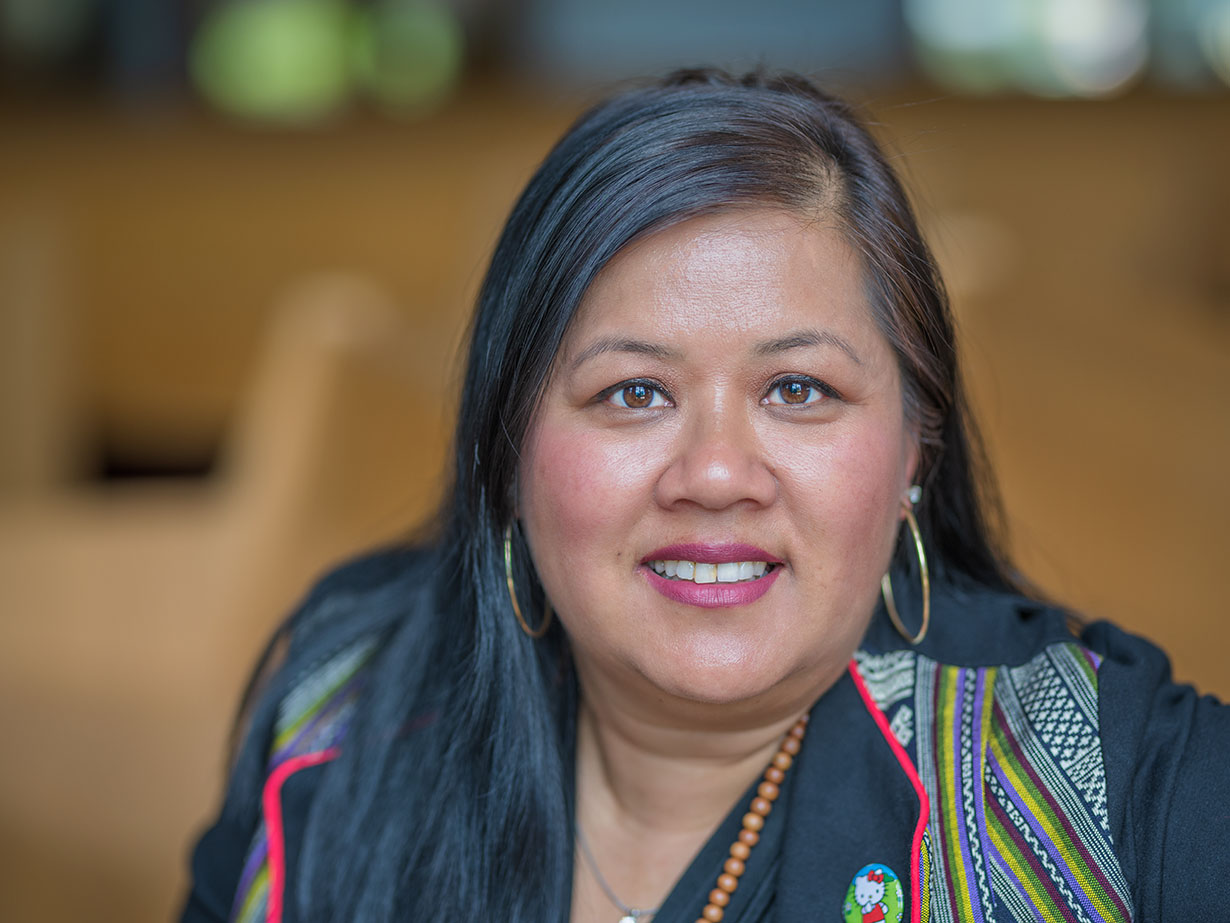The Honorable Chanpone Sinlapasai does not know when she was born. Her Lao tribe did not document any life cycle events. For her American immigration paperwork, Sinlapasai’s family chose May 5, 1975 as her birthdate. She now celebrates that day every year with eight other relatives who share her “refugee birthday.”
Sinlapasai grew up in Houayxay, a small town along the Mekong river in northwestern Laos, toward the end of the country’s civil war. Her father fought alongside the United States in its “Secret War” against the Pathet Lao, a Laotian communist movement associated with the Soviet Union. Decades after the war, former U.S. President Barack Obama acknowledged that nine years of American bombings in Laos equaled more than two million tons of bombs dropped, making Laos the most-bombed country per capita.
“That’s where a lot of my family lost their lives,” Sinlapasai says.
The Pathet Lao won the war in December 1975 and established the country’s current government. Because Sinlapasai’s father had played an active role in opposing the Pathet Lao, Sinlapasai’s family knew it would be too dangerous to remain in Laos. Following multiple attempts, they left the country in 1979, when Sinnlapsai was just four or five years old.
“I don’t remember much of it, but I remember being carried on my mom’s back and my mom telling me not to cry,” she says. “It was the middle of the night. We were running. My mom was barefoot.”
The family fled to a boat that would take them across the Mekong River to Thailand.
“All I remember is gunfire, just gunfire being shot at boats, because all the boats were leaving at the same time trying to escape,” Sinlapasai says. “And all you could see was just red flashes.”
Sinlapasai’s father and uncle swam the boat across the river to safety in northern Thailand at the Ban Mae Surin refugee camp. The family huddled together in one hut with a dirt floor and no walls. Sinlapasai caught malaria and almost died, but her father’s connections with higher-ups in the military enabled her to receive life-saving medication.
Those connections also fast-tracked the family’s immigration process, so after a little more than a year, they left the camp for the United States. Sinlapasai and her family were put on a plane to California with very little instruction beyond that they were going to meet their sponsor — whatever that meant.
“It was very traumatic,” Sinlapasai says. “The only planes we had ever seen were the ones dropping bombs … My mom would not let us eat because she said it was poison because we were now on a military flight.”
The family landed in Los Angeles in July 1980 — and then promptly missed their connecting flight to Stockton, in California’s Central Valley. Once they finally reached Stockton, the entire family — Sinlapasai, her parents, and her little brother — moved in with her uncle’s family in a one-bedroom apartment in the city’s low-income housing. Two dozen family members crowded into the space and slept in rows on the floor. But at least they now had a floor, and walls, and no military planes to keep them awake at night.
Sinlapasai’s parents worked multiple jobs, and the children helped, too. Their community of Southeast Asian and Latinx farmworkers labored together, shared food, and formed friendships, even though they did not speak the same language.
“It was a time that was pivotal for my work as an adult now: being in community in a way where we were all human beings. There was no ranking. Regardless of the color of our skin, the language that we spoke, we were all together trying to survive as a family, as one giant unit on this farm,” Sinlapasai remembers.
As a young girl with broken English, Sinlapasai also served as her parents’ interpreter, witnessing firsthand how poorly her family was treated just because they did not understand English. She experienced indignities like having to camp out all night outside the immigration office because it was first come, first served. After sleeping on the sidewalk, Sinlapasai would wake to find that people with lawyers (and money) had been called to the front of the line.
“Every step of the way, whether it was Social Security, the immigration system, our legal system, reporting a crime, or just accessing food stamps, it was as if we were not seen and we did not matter,” Sinlapasai says.
After several years in Stockton and San Jose, Sinlapasai’s family moved to a house in Milpitas in Silicon Valley. At the time, the town was largely farms and mustard fields. But there were also gangs, street fights, and shootouts.
“Growing up in survival mode, you see things you don’t want to see,” Sinlapasai says. “I’ve had family members who were victims of crimes and I’ve had family members who were the perpetrators … I have witnessed [them] not get their fair share of access to justice through the court system.”
Sinlapasai focused on survival and not on school, lacking the time to prioritize her studies. She loved to read but struggled with English. She had also grown up knowing her family would follow the Laotian tradition and marry her off — for in her home country, most women were denied education. It was not until her senior year of high school that she began to take her studies seriously, after her English teacher, Ms. Bates, recognized her potential.
“She used to tell me, ‘I see you,’” Sinlapasai says. “‘You’re really smart. Your GPA does not reflect that you’re smart, but you’re smart.’”
Ms. Bates gave Sinlapasai books to nurture her love for reading and encouraged her to apply to community college. For the first time, someone focused on Sinlapasai’s dreams for herself.
“She had faith in me,” Sinlapasai says. “No one else did, not even me. I didn’t see my worth or my capabilities.”
Ms. Bates explained that the best way for Sinlapasai to help her family out of poverty was to pursue an education. Ms. Bates was also one of Sinlapasai’s first Asian teachers, an example that someone like her could aim higher.
“That made such a profound impact on me, that there was an educator who looked like me who understood culturally, we could do more, we could be more,” Sinlapsai says. “When I had to focus on me and think of it as, ‘To better myself is to better my family, to better my community,’ then it became a game-changer.”
Sinlapasai’s grandmother and great-grandmother also encouraged her to pursue an education, something they were not able to do in Laos.
“It was their drive and their wisdom of making me think how I could not just be better for this family but for everyone else. Service can be not just through marriage,” Sinlapasai says. “But you have to put your heart in it. My grandmother always said: ‘Don’t just half it. If you’re going to do it, really do it.’”
Sinlapasai tells her story before a live audience in Beaverton in April 2023.
Sinlapasai attended De Anza College, a community college in Cupertino, California, for two years, earning straight As. Her academic honors earned her a spot at Santa Clara University, but she learned that her parents had spent her college fund on a family temple in Laos. So, to put herself through college, Sinlapasai worked two jobs, while double majoring in English and Philosophy.
One of her jobs was at Rambus, a technology company, where she worked her way up from reception to the legal department. When the Chief Financial Officer first interviewed Sinlapasai, he asked her what her career goals were.
“I told him that day I wanted to be a lawyer and I wanted to help people just like me, people like my family,” Sinlapasai says. “That was the first [time] I ever, out of my mouth, said, ‘I want to be a lawyer.’”
Sinlapasai’s coworkers supported her through her college years, buying her a calculator and giving her a gift card so she could buy furniture at law school.
“They saw something in me and believed in me and pushed me,” Sinlapasai says.
In 1999, Sinlapasai moved to Portland to attend Lewis & Clark Law School, which boasts one of the country’s top public interest law programs. During law school, she volunteered at the Asian Family Center of Portland’s Immigrant and Refugee Community Organization (IRCO).
After graduating in 2002, she took a position at IRCO, working on cases involving victims of crime and violence. That led her to Catholic Charities, an organization that was creating a program to combat human trafficking.
In 2007, Sinlapasai co-founded a law firm to help people going through the immigration process. Her personal experience growing up as a refugee helped her connect to clients.
“I really wanted to give back,” she says. “When you’re seen in the community, for the community, it changes the trust relationship of what you can do.”
Sinlapasai married someone she met in law school–they have since divorced. After
three children were born, Sinlapasai moved her parents up to Portland to live with her.
“We have the multigenerational household. Always,” she says. “It’s a way of caring for each other, and it’s also a way of offering respect. Family’s very, very important and close. That’s how we survived the war, that’s how we survived the refugee camps, that’s how we survived in the U.S. … We had a unit all the time.”
During the Trump administration’s travel ban on Muslim-majority countries, Sinlapasai often went to Portland International Airport to welcome new immigrants and refugees. She also worked on federal litigation concerning affected travelers, suing the government and filing petitions with civil rights groups across the country. But she wanted to do more to help individuals on a personal level.
“I wanted to help change a system from within that didn’t have the lens of a refugee experience. … I wanted us to re-handle the way that we approach our legal system from a very holistic level,” Sinlapasai says. “And in order to do that, I couldn’t be a lawyer. I had to be part of the judicial system.”
In September 2021, Sinlapasai became the nation’s first Laotian judge when she was sworn in as a circuit court judge by Gov. Kate Brown.
“What I really want to continue doing is learning … how to better serve our community in different ways. My goal, especially in being a Multnomah County judge, is to make judges accessible to our community,” Sinlapasai says.
Sinlapasai presides over both civil and criminal cases. Her favorite part is officiating marriages, happy moments in days that are often filled with horrific cases. But those kinds of cases are the reason Sinlapasai decided to become a judge: to help people like her and her family who the system often overlooks.
Asked how she sees the meaning of her life story so far, Sinlapasai says: “It’s the love of family in shaping who I am, and my passion for community and service and giving back. My lived experience ensures there are opportunities for others by breaking those bamboo ceilings and those glass ceilings, especially for women like myself. I’m not supposed to be here based on the global numbers, but also by my gender, my race, my indigenous family. All the odds are against me.
“I’m not supposed to be here. But I am here.”

